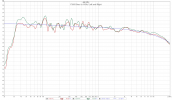Prana Ferox
Addicted to Fun and Learning
Looking at it one way:
- Making a speaker flat or especially sloping up to 20 hz runs into Hofmann's Iron Law; the speaker tends to be large and require a ton of power. Drivers are likely to require large xMax which drives compromises elsewhere in the frequency response (or requires them to essentially become built in subs for multiway uppers.)
- These are somewhere between unacceptable and impossible characteristics for all but the biggest floorstanders. Certainly not feasible for routine bookshelves
- Thus the bass response claims of most speaker manufacturers are bunk
- They can get away with this because room response and gain play such hell with the lowend FR regardless
Alternately:
- Room response can be hard to predict or correct for, for the vast majority of consumers
- Room gain can be dramatic and generally a hot signal (peaks) is more offensive than a cold one (valleys)
- At the very least a 'flat' speaker would sound crappy in at least 50% of rooms and placements, where it would be boosted - but actually with standing waves it's more likely to have some frequencies noticeably boosted, potentially offensively, in almost all rooms and placements
- Therefore to avoid offensive sound it is best to roll off the bass some degree to tame the worst potential room gains... which are heavily dependent on placements that will vary by speaker design (a sane person doesn't put a floorstander on a bookshelf etc.) As such, at best, different speaker form factors would have different 'ideal' curves, but not with any kind of uniformity that you could say "This is a 6.5" bookshelf, it should follow this curve."
This is further complicated by the Fletcher-Munson curves where a speaker that is tuned to be more 'bass-shy' at lower volumes will sound better when cranked (until it runs out of steam) and a flatter one with the volume low will sound boomy when loud.
- Making a speaker flat or especially sloping up to 20 hz runs into Hofmann's Iron Law; the speaker tends to be large and require a ton of power. Drivers are likely to require large xMax which drives compromises elsewhere in the frequency response (or requires them to essentially become built in subs for multiway uppers.)
- These are somewhere between unacceptable and impossible characteristics for all but the biggest floorstanders. Certainly not feasible for routine bookshelves
- Thus the bass response claims of most speaker manufacturers are bunk
- They can get away with this because room response and gain play such hell with the lowend FR regardless
Alternately:
- Room response can be hard to predict or correct for, for the vast majority of consumers
- Room gain can be dramatic and generally a hot signal (peaks) is more offensive than a cold one (valleys)
- At the very least a 'flat' speaker would sound crappy in at least 50% of rooms and placements, where it would be boosted - but actually with standing waves it's more likely to have some frequencies noticeably boosted, potentially offensively, in almost all rooms and placements
- Therefore to avoid offensive sound it is best to roll off the bass some degree to tame the worst potential room gains... which are heavily dependent on placements that will vary by speaker design (a sane person doesn't put a floorstander on a bookshelf etc.) As such, at best, different speaker form factors would have different 'ideal' curves, but not with any kind of uniformity that you could say "This is a 6.5" bookshelf, it should follow this curve."
This is further complicated by the Fletcher-Munson curves where a speaker that is tuned to be more 'bass-shy' at lower volumes will sound better when cranked (until it runs out of steam) and a flatter one with the volume low will sound boomy when loud.


